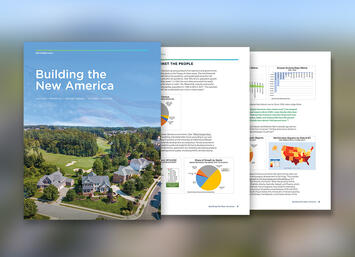
This new report examines the housing trends that are driving today's migration of people and jobs, and suggests a strategy that better fits the aspirations of most Americans. Below is a summary of the report and a link to download the full report:
For generations Americans have voted with their feet—and their dollars—to achieve what has long been called “the dream,” namely, a home of their own, usually in a low- to mid-density community. This preference has existed for decades, and despite media assertions of a generational shift back to dense, urban living, the statistical evidence shows quite the opposite.
The prevailing pattern is evident in the migration of both people and jobs. There are essentially two different migrations, one within major metropolitan areas and another between them. In both cases, as we will demonstrate, growth has gone towards more suburban, and often less expensive, metropolitan areas. These trends have been evident for decades, and were increasing before the pandemic, but have accelerated since then.
Yet if people have their own aspirations, those who designate themselves as knowing best—notably urban planners, large financial institutions, tech companies, and academics—prefer another scenario for ordinary people. Rather than allow the market to reveal what people want, there has been a mounting effort, here and in most of the developed world, to shoehorn people into dense development and, in some cases, ban zoning entirely for single-family homes. These policies are supported by urban planners and core city developers who finance lobby groups to push the densification agenda. To be sure, higher density areas, particularly legendary cities like New York, will continue to appeal to the young, the childless, and the ultra-affluent. But for most people, particularly as they move into adulthood and form families, a more spacious, dispersed environment is preferred.
This sets the stage for a major long-term conflict. Many states, notably California, Washington, Hawaii, and Oregon, have imposed strict policies against “urban sprawl,” and similar policies have been implemented in metropolitan areas such as Denver and Miami. These policies are strongly associated with soaring home prices and have reduced the rate of homeownership, which is at the heart of the American dream. These policies are increasingly tied to dubious assertions about climate and environment which suggest that the Earth goddess Gaia, as it were, prefers her people packed in small spaces.
In reality, suburban, exurban, and small-town environments are becoming more environmentally friendly, as seen in some stunning new developments. The shift to remote work makes dispersion not only more feasible, but more energy efficient. Meanwhile, a harsh approach to climate mitigation or adaption threatening the basic quality of life could render climate change responses politically unsustainable.
Finally, we need to confront the social downsides of housing policies that force density on a public that doesn’t want it. The current planning regime works to make homeownership increasingly difficult, particularly for millennials and our increasingly diverse population. The lack of affordable, family-friendly homes is linked to low marriage and fertility rates, as people who own their homes are far more likely to have children. In a country with record low fertility, facing a shrinking workforce and an aging population, this does not bode well for America’s future.
The fact is that for most people, the densification agenda means a lower standard of living. Reducing the standard of living is not an appropriate role for urban planning.
Our report suggests an alternative strategy, one that better fits the needs and aspirations of most Americans. It focuses on new technologies to make communities more sustainable and affordable, and stresses people’s preferences. We are calling on Americans to do what they have always done best—create a better future for the next generation.
Read/download the full report.
The report was authored by Joel Kotkin, Wendell Cox, Marshall Toplansky, Tory Gattis, and Mark Schill. The summary excerpted above is by Joel Kotkin and Wendell Cox.
Joel Kotkin is the author of The Coming of Neo-Feudalism: A Warning to the Global Middle Class. He is the Roger Hobbs Presidential Fellow in Urban Futures at Chapman University and Executive Director for Urban Reform Institute. Learn more at joelkotkin.com and follow him on Twitter @joelkotkin.
Wendell Cox is principal of Demographia (St. Louis, MO-IL), a demographics and public policy firm. He was appointed by Mayor Tom Bradley to three terms on the Los Angeles County Transportation Commission, which was a predecessor to the Los Angeles County MTA. Speaker Newt Gingrich appointed him to the Amtrak Reform Council. He specializes in demographics and urban affairs. He is co-author of the Demographia International Housing Affordability Survey and author of Demographia World Urban Areas, A Question of Values: Middle-Income Housing Affordability and Urban Containment Policy, Canada’s Middle-Income Housing Affordability Crisis, and the Urban Reform Institute Standard of Living Index. He is a senior fellow at member of the Board of Advisors at the Center for Demographics and Policy at Chapman University, the Urban Reform Institute (Houston) and the Frontier Centre for Public Policy (Winnipeg).












